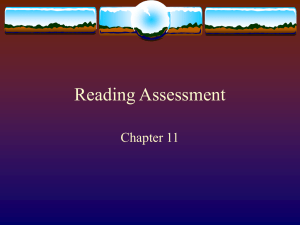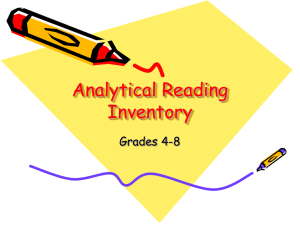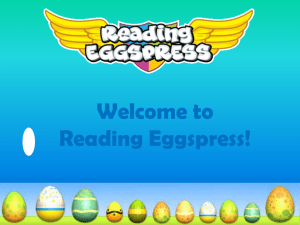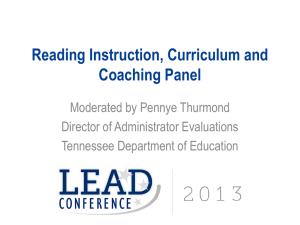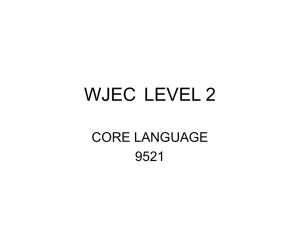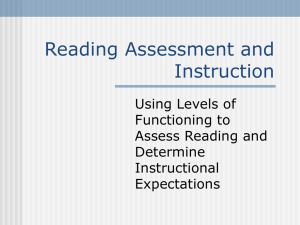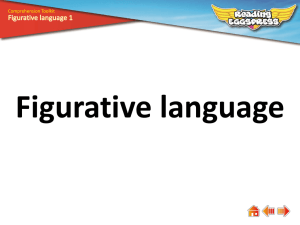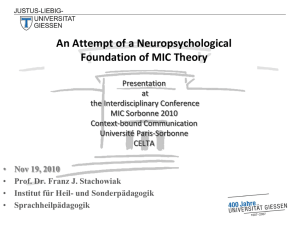Class 8 - CTE - Online Learning Management System
advertisement
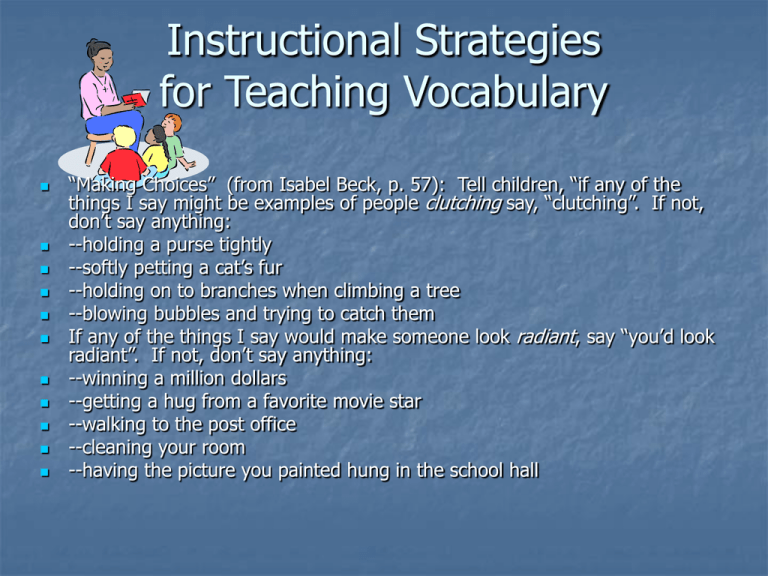
Instructional Strategies for Teaching Vocabulary “Making Choices” (from Isabel Beck, p. 57): Tell children, “if any of the things I say might be examples of people clutching say, “clutching”. If not, don’t say anything: --holding a purse tightly --softly petting a cat’s fur --holding on to branches when climbing a tree --blowing bubbles and trying to catch them If any of the things I say would make someone look radiant, say “you’d look radiant”. If not, don’t say anything: --winning a million dollars --getting a hug from a favorite movie star --walking to the post office --cleaning your room --having the picture you painted hung in the school hall Great Vocabulary Books! Favorite books which motivate children about vocabulary learning Academic Notebooks (Mazano refers to a spiral notebook or threering binder; he has a major section devoted to student sustained silent reading and other sections are reserved for subject vocabulary.) Rosenblatt & Iser: it’s important for students to interact with what they read; teacher facilitates student interactions and responses. Repeated exposure to words helps content be stored in permanent memory. When teachers facilitate student interaction on vocabulary, then this increases the amount of exposure students have to information –expands their language experience base. The more students learn about a topic, the more they want to share it with others. They become validated in their enthusiasm! Vocabulary Instruction & Sustained Silent Reading Marzano: Students should have direct vocabulary instruction on content vocabulary. Comprehension will increase by 33 percentage points when vocabulary instruction focuses on specific words important to the content they are reading. Isabel Beck’s thoughts Independent Reading and R5 Alternate Reading Program Share Edmark Qualitative Reading Inventory Word Identification: (automaticity— measures correct words per minute; % of words correctly identified (includes decoding) Word Recognition in Isolation (WRI) : flash & untimed How to select leveled passages (**Note: QRI is on reserve at the library!) Word Recognition in Context Passage Comprehension (Pre-primer through high school; narrative & expository text; prior knowledge, predictions, retelling, explicit & implicit questions) Word Lists Measure accuracy of word identification Speed & automaticity of word identification Determine starting point for reading passages Cooter Comprehensive Reading Inventory uses sentences to find level of reading passages Reading Passages Estimate reading level & begin there Concept questions for background knowledge Oral and silent reading Different types of text: narrative or expository Measuring Comprehension Retelling or unaided recall Two types of questions --implicit & explicit Look Backs --without lookbacks—comprehension by memory --with lookbacks – comprehension during reading; ability to skim Materials Needed Student instructions handout Copies of word lists (use index card or card with window cut out as shown before) Copies of stories Copies of record keeping sheets Develop your own system of organization (e.g. notebook, plastic sleeves or laminated copies of stories) Administering Word Lists Rule of Thumb: Start two grades below grade level (or administer word list & find out where child is scoring at least 70%) How accurate when identifying words? How automatic when identifying words? What decoding strategies are used by student? Difference between words in isolation versus words in context? Administering Word Lists Read directions for word lists to student Scoring: --identified automatically (within a second) --identified but delayed (sounded out or delayed) Self correction – write “c” and count as correct Administering Word Lists Find independent, instructional & frustration levels Independent: Total correct: 90% & above, 1820 words Instructional: Total correct: 70-89%; 14-17 words Frustration: Total correct: Less than 70%; 13 words or less Once at frustration, STOP! Passage Administration Use word list level to estimate beginning passage or starting point – highest independent word list level Assess prior knowledge – use concept questions Passage Reading --select passage based on independent word list reading --can tape record – prepare student --do not supply words --read directions to students --record miscues/determine instructional level Concept Questions Assessing Prior Knowledge Students who have background knowledge of ideas and understand vocabulary prior to reading the text are more successful with comprehension Scoring (QRI-4: pages 55-58) 3 points 2 points 1 point 0 points Comprehension Scoring QUESTIONS EXPLICIT: Answers must come from passage Do not count answer that comes from prior knowledge; no ½ points IMPLICIT: Answer must relate to a clue in the passage Be sure to QUERY – what clues in the passage tell you? Comprehension Scoring Five Questions: Independent Level, 5 correct; Instructional Level, 4 correct; Frustration Level, 0-3 correct Six Questions: Independent Level, 6 correct; Instructional Level, 4-5 correct; Frustration Level, 0-3 correct Eight Questions: Independent Level, 8 correct; Instructional Level, 6-7 correct; Frustration Level, 0-3 correct Ten Questions: Independent Level, 9-10 correct; Instructional Level, 7-8 correct; Frustration Level, 0-6 correct Assessing Listening Comprehension Good to measure when student has difficulty reading and comprehending at the primer level Assessing level of material that student can understand when material is read to him or her Allows teacher to see if student can benefit from orally presented material at his or her grade level Evaluated same way as oral or silent reading Examiner reads passage to student Student retells what s/he heard and answers specific questions How To Interpret Results Independent Level= the level at which a student can read successfully without assistance. Teacher should choose material written at this level for free reading pleasure or for independent tasks. Also good for fluency practice at independent level (98% oral reading accuracy and 90% comprehension on word lists) Instructional Level = the level at which a student can read with assistance. Oral reading may be less fluent at this level, but it should contain some sense of rhythm and expression. Materials written at this level should be chosen for reading and content area instruction. The teacher introduces concepts and gives background knowledge necessary for the understanding of the material. (9597% oral reading accuracy and 70%+ comprehension and word lists) Interpreting Results (Continued) Frustration Level= teachers should avoid material that is at the frustration level. At this level, the student is completely unable to read the material with adequate word identification or comprehension. (less than 90% oral reading and less than 70% comprehension and word lists.) Differences in Vocabulary Development Profound differences in vocabulary development and knowledge among learners in various socio-economic groups --first graders from higher socio-economic status groups knew about twice as many words as lower socioeconomic status children (Graves, Brunetti & Slater, 1982; Graves & Slater, 1987) --high school seniors near the top of their class knew about four times as many words as their lower performing classmates (Smith 1941) --high knowledge third graders had vocabularies about equal to lowest performing 12th graders (Smith, 1941) --Once established, such differences appear difficult to ameliorate (Biemiller, 1999; Hart & Risley, 1995) What’s Happening with vocabulary instruction and how do children learn words? Before 2001, studies found very little vocabulary instruction in schools—a robust approach involves directly explaining the meanings of words along with thought-provoking, playful interactive follow up. Learning words from context? It does occur, but in the course of reading, research shows in small increments. (Not every word is learned, and those that are learned need multiple encounters; of 100 unfamiliar words met in reading, between 5 & 15 will be learned (Beck, p. 3) (This presupposes that children are reading extensively where they encounter more challenging words & that they could infer meaning from context!!!) Misdirective contexts, nondirective contexts, general contexts & directive contexts Many natural contexts are not all that informative for deriving word meanings. There were many contexts which would confuse children. (Examples, p. 4-5, Beck) Misdirective Contexts: those that rather than revealing the meaning of the target word, seem to direct the student to an incorrect meaning Nondirective contexts General contexts Directive contexts Written context: important source for new vocabulary, but relying on learning word meanings from independent reading is not an adequate way to deal with students’ vocabulary development. How one knows a word Can be described along a continuum No knowledge General sense Narrow, context-bound knowledge, Knowledge of a word by not being able to recall it readily enough to use it in appropriate situations Rich, decontextualized knowledge of a word’s meaning, it’s relationship to other words, and it’s extension to metamorphorical uses Contextual Clues to teach students External context clues: meaning cues in the text surrounding a new vocabulary word Internal context clues: prefixes, suffixes and stems Studies show that instruction above had a moderate impact on students’ ability to utilize context clues In 4 out of 14 studies, students used context cues in absence of any instruction and they did as well as students who received instruction in using context! (So being prompted to use context and having time to practice is as powerful as much more elaborate instruction.) Evidence that teaching morpheme (the smallest units of meaning like prefixes, suffixes, root words) can improve children’s and adults’ skills at inferring the meanings of words. Language Development Most talked about study (Hart & Risley’s Meaningful Differences in Everyday Experiences of Young American Children (1995): Authors observed 42 families over 2 years beginning when each participating child was 6-9 months old. (Families were from all socio-economic groups.) The amount of language a child experienced varied dramatically as a function of social class. The less affluent the family, the less was said to the child. Clear relationship between the quantity and quality of input of children’s vocabulary development. Children who experienced the most language in the first three years of life were, with the parent’s language interactive style the very strongest predictor of reading achievement. Reading with children can increase vocabulary – the more parents interact with children over books, the better developed is the children’s vocabulary – increases children’s language competence. Exciting are studies to support parents in the ways to help their children the most. Flood classroom with vocabulary rich talk during formal lessons & informal interactions. Urge more systematic attention to vocabulary – when vocabulary acquisition has had an impact on reading –increased reading comprehension. Notes Halfway Through our Course! Louisa Moats’ article (Summer 1995) on the “Missing Foundation in Teacher Education” – “graduate level teachers are typically undereducated for the very demanding task of teaching reading and spelling explicitly.” (Gives evidence of gaps of knowledge & how important that is to linguistic instruction; policy changes occurred Update on Personal Goal and my support to help you Other Four minute feedback! Teaching Word Parts Teaching roots, affixes has been traditional for vocabulary development Adams (1990): logic of teaching word parts (i.e. for “duce” means to lead, & helps children with produce, seduce, induce. However, teaching beginning or less skilled readers about these may be a mistake. (In word study program, these don’t appear until child is developmentally after the mid-fourth grade level!) Affixes Prefixes augment the meaning of words Suffixes change the part of speech of words to which they are attached Prefix “un” accounts for 26% of total number of prefixed words More than half (51%) of the prefixed words have “un”, “re” and “in”(not) Four prefixes (un, re, in and dis) account for 58% of prefixed words! Six Lessons for Affixes by White & colleagues Teacher gives concept of prefix (difference between unkind and refill and trick words such as uncle & reason Teacher explains meaning of “un” and “dis” Addresses negative meanings of in, im, ir & non Address less common meaning of un and dis (do the opposite) and less common meaning of in and im (in and into Teacher explains and exemplifies and meanings of en, em, over and mis Relationship Between Grammatical Awareness & Reading Syntax is grammar—derived from Greek word for “arrangement” Syntax is the “way in which words are arranged to show relationships of meaning within and sometimes between sentences Chomsky (who developed most influential theoretical frameworks for syntax said that humans are biologically predisposed to acquire language True! By age five, children master the syntax rules of their native languages and their language is more adult like! Their knowledge of syntax is implicit! Children who perform well on measures of grammatical awareness (from speech therapists’ text on syntactic absurdities—Rides Sally bike her—make a sentence) tend to be good readers. Good readers who have greater sensitivity to syntax could monitor reading better. Then why do poor readers have difficulty with this? Syntactic awareness is one aspect of more general language delay or deficit in language. It could be a deficit in grammatical awareness is indicative of more global language problem. Grammatical Awareness & Reading, Continued Lots of studies show correlation between early deficits in language & reading difficulties well into adolescent years. Those with understanding language are at most risk. Even those with expressive language problems are at some risk. Other researchers: deficits in working memory cause what appears to be deficits in syntactic skills Some linguistic deficits may be a consequence of reading disabilities rather than the effect of preexisting language problems. Good readers read more than poor readers and are exposed to more language. What Can Parents & Teachers Do? (to support syntax) Model complex syntax in conversations with children Ask questions so children elaborate on and extend their ideas Parents should read aloud to children with reading disabilities – expose children to books that are linguistically more complex than they are capable of reading Use reciprocal teaching to help children with text that has more complex syntax: is technique for more strategic readers—uses questioning, clarifying, predicting and summarizing. Teachers can read ahead & find difficult sentences or portions. Teacher can model questions to help clarify meaning: Who was doing the action? What are they doing? Where are they? What happened first? If kids answer correctly, say, “How did you know? Children can go back and reread in text to support their answers. Clarifying step can also be used to help with misunderstandings: students could restate difficult sentences in their own words. They could use background knowledge and overall context to comprehend complex sentences.
